![]()
Scottish Paperweights & Related Objects for Sale
![]()
Scottish Paperweights & Related Objects for Sale
The birth of Scottish paperweight making is credited to the glass making family of Salvador Ysart, who moved to Crieff, Scotland in 1922. They worked first at John Moncrieff Ltd and made the earliest Scottish paperweights during that period. In 1946 Salvadore and his sons Augustine and Vincent founded Ysart Brothers Glass and produced glass wares under the Vasart label. Salvador Ysart died in 1955 The company name was later changed to Vasart Glass.
Stuart Drysdale was hired manage the business side of the enterprise in 1960. Vincent Ysart was the Works Manager. George Dunlop provided a portion of the financial backing. The senior craftsman, Jack Allan, was assisted by two glass blowers and a few apprentices.
Strathearn Glass was formed in a reorganization of Vasart glass in 1963. The new company was owned by Teachers Whiskey.
In 1967 Drysdale was sent a magazine article on antique paperweights (Woman's Day, July 1965). The inspired him to try to produce weights comparable to the French antiques. With this goal in mind, he and several of the glass workers left Strathearn to found Perthshire in 1968. From that start we have several Scottish Paperweight companies, including Caithness, John Deacons, William Manson, Peter McDougall, Phoenix, and Selkirk. Be sure to also check out my Perthshire page.
Peter McDougall was one of the very young glass workers who left Strathearn in 1968. When Perthshire closed in 2002 he was the head craftsman of Perthshire. Peter now has his own studio PMcD Glass Studio and makes paperweights under his own name. For a selection of Peter's paperweights, see my PMcD page.
John Deacons, another Scottish glass worker, also started his glassmaking career at Strathearn Glass in 1967. A year later in 1968, he left Strathearn and joined the new Perthshire venture. After about ten years at Perthshire he decided to leave and start his own company, Jay Glass, in 1978, which remained in operation until 1983. During that period, it produced paperweights under the Jay Glass label and also others signed St.K for St. Kilda and JD for John Deacons. John Deacons continues to make paperweights under his own label today.
Caithness Glass was founded by Robin Sinclair in Wick in north eastern Scotland in 1961. The factory did not start making paperweights until 1962 when Paul Ysart joined Caithness. Colin Terris joined Caithness in 1968 and started the modern line of paperweights in 1969. A second factory was opened in Oban in 1969 and the Perth factory opened in 1979. In 1980, Caithness purchased the Whitefriars name and designs. More recently Caithness recently went through a number of changes of ownership. After going into receivership in 2004, it was purchased by Edinburgh Crystal, but went into receivership again in 2006. Finally, it was bought out of receivership by Dartington Crystal. The factories in Wick, Oban and Perth all closed and were replaced by a smaller operation and visitors' center in Crieff.
Allan Scott apprenticed at Perthshire and then joined Jay Glass shortly after it started and was responsible for much of the lampwork. When Jay Glass closed in 1983, he joined Caithness Glass where he stayed until 2007.
William Manson, Sr. started his glass working career at Caithness Glass at the age of 15 in the 1960s. He apprenticed with Paul Ysart. Manson left Caithness in 1971 to work at Ysart's Harland Glass and rejoined Caithness several years later in 1974. He was at Caithness on and off between 1974 and 1997 when he left for good to form his own studio William Manson Paperweights. His son William Manson, Jr. started making paperweights alongside his father starting in 1992. For a brief period (2004-2005), William Manson, Sr. made collaborative paperweights with John Deacons.
Phoenix Paperweights was a small company started by William Manson Sr. to engage three workers from Perthshire after Perthshire closed in January 2002. They only lasted a year and issued paperweights in 2002 and 2003 before closing in August 2003. Phoenix operated in the Manson works in Perth, Scotland. The glass workers were William Manson Sr., David McNichol (paperweight maker), Duncan Smith (lampworking), and Gordon Taylor (glass cutter). Some of the lampwork was also done by Rosette Fleming. The 2003 Phoenix catalog lists William Manson Paperweights as the distributor.
Another Scottish factory was Selkirk founded in 1977 by Peter Holmes and Ron Hutchinson. Peter apprenticed under Paul Ysart at Caithness from 1963 and continued at Caithness until 1977. Ron Hutchinson was also at Caithness. Selkirk produced a wide range of paperweight styles including abstract, lampwork and millefiori paperweights. The company was located in Selkirk, Scotland in the Borders Region. At some point they were purchased by Edinburgh Crystal and remained in operation until 2006. Peter Holmes left Selkirk in 2002 to start Scottish Borders Art Glass with his son, Andrew, at Galalaw, Hawick.
For more information, you can read about the Scottish paperweights in these two books:
And of course you might want to look at the Woman's Day article that inspired Stuart Drysdale to found Perthshire. For these and other great references on paperweights, check out my list of paperweight books for sale.If you would like to purchase
any of these paperweights, e-mail me at: aport@paperweights.com
| 6044 | Magnum John Deacons Gordon
Taylor White PomPon Chrysanthemum Faceted Swirl
Paperweight. circa 2020. This very
large faceted paperweight features a magnificent white pompon
(chrysanthemum) flower with seven green leaves and stem placed on
a blue and white swirl ground. The flower is very
detailed. The swirl ground is made of fifteen blue and five
white stringers (rods of glass). The stringers are arranged
in groups of four and wrap around to the base. This
paperweight is faceted with a large top facet and six side
facets. The faceting was done by Gordon Taylor. It is
signed on the base with a "JD" signature cane and also has Gordon
Taylor's engraved "GT" below the signature cane. A wonderful
paperweight showcasing the artistry of John Deacons and Gordon
Taylor. Note: The original spelling of this flower is from the French Pompon but it is often spelled Pompom (with and without a hyphen). Take your choice. The birth of Scottish paperweight making is credited to the glass making family of Salvador Ysart, who moved to Crieff, Scotland in 1922. They worked first at John Moncrieff Ltd and made the earliest Scottish paperweights during that period. In 1946 Salvadore and his sons Augustine and Vincent founded Ysart Brothers Glass and produced glass wares under the Vasart label. Salvador Ysart died in 1955 The company name was later changed to Vasart Glass. Strathearn Glass was formed in a reorganization of Vasart glass in 1963. John H. Deacons learned his craft
at Strathearn Glass in Crieff, Scotland in 1967. When
Perthshire was formed in 1968, he left Strathearn to move to
Perthshire and worked there for 10 years before leaving in
1978 to start his own glass studio. He has produced
paperweights and other glass objects under a variety of
labels, including J Glass, St. Kilda, and now under his own
name. Some of the lines were produced
simultaneously. J Glass was produced from 1978 to
1983. The St. Kilda line was produced from 1978 or 1979
through 1987. You can read about John Deacons in the
book by Hall - Scottish Paperweights. Today John
works at his own studio with
his son Craig. Very large size: Just over 3 1/8" diameter by 2
1/8" high. The base is polished concave. It is faceted
with one large top facet and six side facets. For extra pictures, click on the picture at the right and the following links: Large picture$345 postage paid in the US. Click on the picture to see a larger image. |
Click
on the picture to see a larger image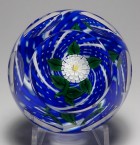 |
| 6257 | Caithness 1974 Colin Terris Peter Holmes
Genesis Limited Edition Abstract Paperweight.
dated 1974. This abstract Caithness paperweight depicts the
beginning of the universe in black forms and clear glass. It
was designed by Colin Terris and made by Peter Holmes. It
comes with its original (marked up) certificate noting that it was
issued in a limited edition of 500 paperweights of which this is
number 342. It is engraved on the base "GENESIS CT/PH
1974 CAITHNESS SCOTLAND 342/500". Something different from
the early Caithness years. Note: The signature on the base was difficult to capture in one picture, so be sure to examine both pictures of the signature. This design is listed and designated CT-22 on page 8 of the Charlton Standard Catalog of Caithness Paperweights. It was designed in 1973 by Colin Terris and made by Peter Holmes. It was issued in a limited edition of 500 paperweights which was fully subscribed. Production continued into 1974 when this paperweight was made. Caithness Glass was founded by Robin Sinclair in Wick in north eastern Scotland in 1961. The factory did not start making paperweights until 1962 when Paul Ysart joined Caithness. Colin Terris joined Caithness in 1968 and started the modern line of paperweights in 1969. A second factory was opened in Oban in 1969 and the Perth factory opened in 1979. In 1980, Caithness purchased the Whitefriars name and designs. More recently Caithness recently went through a number of changes of ownership. After going into receivership in 2004, it was purchased by Edinburgh Crystal, but went into receivership again in 2006. Finally, it was bought out of receivership by Dartington Crystal. The factories in Wick, Oban and Perth all closed and were replaced by a smaller operation and visitors' center in Crieff. Caithness is still operating in Crieff and making paperweights today (in 2022). Large size: Just over 3" diameter by 2 3/8"
high. The base is polished flat. For extra pictures, click on the picture at the right and the following links: Large pictureSOLD. Click on the picture to see a larger image. |
Click
on the picture to see a larger image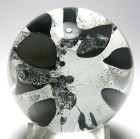 |
| 6211 | Magnum Caithness William
Manson African Chameleon Paperweight -
Limited Edition. issued 1995. This
wonderful paperweight features a large African chameleon on a
rocky sand ground. It was designed by William Manson and
issued in a limited edition of 50 paperweights of which 43 were
made. This is edition number 34. The chameleon is
stepping over some matching foliage and flora. The
paperweight is signed with a William Manson "WM" signature cane in
the design and engraved on the base "African Chameleon Caithness
Scotland 34-50". A beautiful design with wonderful
execution.. The African Chameleon design is listed and designated CT-1249 on page 181 of the Charlton Standard Catalog of Caithness Paperweights. It was designed by William Manson and released in a limited edition of 50 paperweights in 1995 and the edition closed at number 43. The original issue price in the US was $895.00. Caithness Glass was founded by
Robin Sinclair in Wick in north eastern Scotland in
1961. The factory did not start making paperweights
until 1962 when Paul Ysart joined Caithness. Colin
Terris joined Caithness in 1968 and started the modern
line of paperweights in 1969. A second factory was
opened in Oban in 1969 and the Perth factory opened in
1979. In 1980, Caithness purchased the Whitefriars name
and designs. More recently Caithness recently went
through a number of changes of ownership. After going
into receivership in 2004, it was purchased by Edinburgh
Crystal, but went into receivership again in 2006.
Finally, it was bought out of receivership by Dartington
Crystal. The factories in
Wick, Oban and Perth all closed and were replaced by a smaller
operation and visitors' center in Crieff.
Caithness is still operating in
Crieff and making paperweights today (in 2022). Very large size: Just under 3 9/16" diameter by 2
9/16" high. The base is polished flat. For extra pictures, click on the picture at the right and the following links: Large picture$745 postage paid in the US. Click on the picture to see a larger image. |
Click
on the picture to see a larger image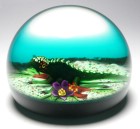 |
| 6254 | Large Strathearn Eight Pointed Star
Paneled Millefiori Paperweight with Opaque Rust Red Ground.
circa 1963-1968. This paperweight is finished as a eight
pointed star. The star points give the glass a glittery
appearance. It features a crisply executed paneled
millefiori design with seven panels of 1+2+2 millefiori patterns
each separated by a white latticinio twist cane. There is a
central ring of six millefiori canes and then a center millefiori
cane. The canes are early Scottish millefiori canes on an
opaque rust red ground. The paperweight is engraved
"STRATHEARN SCOTLAND" on the base, but this is probably a later
addition, not a factory signature. A great addition to any
collection of Scottish glass. This is called a pressed weight because a mold is used to form the shape. The top is flattened. The star points give the glass a real glittery appearance as you can see in the pictures. The birth of Scottish paperweight making is credited to the glass making family of Salvador Ysart, who moved to Crieff, Scotland in 1922. They worked first at John Moncrieff Ltd and made the earliest Scottish paperweights during that period. In 1946 Salvadore and his sons Augustine and Vincent founded Ysart Brothers Glass and produced glass wares under the Vasart label. Salvador Ysart died in 1955 The company name was later changed to Vasart Glass. Strathearn Glass was formed in a reorganization of Vasart glass in 1963. The new company was owned by Teachers Whiskey. Size: Just over 3" diameter across the star
points by 1 3/16” high. The base is fire polished. For extra pictures, click on the picture at the right and the following links: Large picture$95 postage paid in the US. Click on the picture to see a larger image. |
Click
on the picture to see a larger image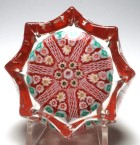 |
| 1938 | Vasart / Lassman Concentric Millefiori
Paperweight Handle Corkscrew. circa 1950s-1960s.
This corkscrew has a concentric millefiori paperweight
handle. The firm of Lassman & Co. designed and produced
this corkscrew and a variety of other useful objects during the
1950s and 1960s. The attractive millefiori paperweight
handle was made by the Ysart family of Scotland under the Vasart
label. The handle has a two ring concentric millefiori
pattern. The design is set on an opaque white ground.
The chrome plated metal screw part and other hardware were made by
Lassman and the assembly was also done by them. A fun
collectible. The maker of this item was Lassman & Co. located in the Kilburn area of North London. Samuel Lassman purchased the paperweight handles from George Dunlop's Pirelli Glass in London. Pirelli obtained them from Vasart. Pirelli also took some assembled inventory back from Lassman and sold the barware items under the Pirelli label. Pirelli also included the line in their 1959 catalog. For more information, see my web page on Lassman & Co. or the article by Angela Bowey and Allan Port “Pirelli, Vasart and the Ysart Family” in the Paperweight Collectors Association Inc. Annual Bulletin 2015. The barware line was sold individually and also in complete box sets. Lassman also made a line of large industrial sized corkscrews - called packing gland extractors and used for servicing nautical applications that required a waterproof seal. The birth of Scottish paperweight making is credited to the glass making family of Salvador Ysart, who moved to Crieff, Scotland in 1922. They worked first at John Moncrieff Ltd and made the earliest Scottish paperweights during that period. In 1946 Salvadore and his sons Augustine and Vincent founded Ysart Brothers Glass and produced glass wares under the Vasart label. Salvador Ysart died in 1955 The company name was later changed to Vasart Glass. Stuart Drysdale was hired manage the business side of the enterprise in 1960. The company evolved into a new company Strathearn owned by Teachers Whiskey. In 1967 Drysdale was sent a magazine article on antique paperweights (Woman's Day, July 1965). The inspired him to try to produce weights comparable to the French antiques. With this goal in mind, he and several of the glass workers left Strathearn to found Perthshire in 1968. Size: 1 7/16" diameter. With the metal
hardware, it is 4 3/8" long. For extra pictures, click on the picture at the right and the following links: Large picture$79 postage paid in the US. Click on the picture to see a larger image. |
Click
on the picture to see a larger image |
| 5017 | Late Ysart Brothers or Early Vasart
Paneled Millefiori Paperweight - Many Annealing Cracks.
circa 1952-1956. This colorful paperweight consists of a
paneled millefiori pattern with eight sections with 1 green +2
brown millefiori canes each separated by a red and blue twist
cane. There is a central cluster of two rings of canes, 15
blue and 5 orange canes, around a central cross cane. The
design is set on a clear ground. The glass is slightly
gray. Unfortunately this paperweight is filled with
many internal annealing fractures / cracks. See the note
below for more information on the cause. An interesting
historical addition to any collection of Scottish paperweights. Note on annealing fractures / cracks: According to David Moir, who was an apprentice at the Ysart Brothers Shore Road works in 1954, the glass works had a lot of annealing problems at the Shore Road factory because it was fired with poor quality coke. It was difficult to maintain a level annealing temperature and sometimes would get too hot or too cold. Temperature was judged by putting your arm inside the oven to feel the heat. The problem was solved when George Dunlop (owner of Pirelli Glass in London) brought in fresh capital, equipment, and orders. This included an electrically controlled second-hand kiln from Rolls Royce which was a vast improvement on the old one and had electric temperature gauges. The birth of Scottish paperweight making is credited to the glass making family of Salvador Ysart, who moved to Crieff, Scotland in 1922. They worked first at John Moncrieff Ltd and made the earliest Scottish paperweights during that period. Paul Ysart (1904-1991), originally Pablo Moreno Isart, was apprenticed to his father as a glass worker at Moncrieff in 1922. In 1946 Salvadore and his sons Augustine and Vincent founded Ysart Brothers Glass and produced glass wares under the Vasart label. Salvador Ysart died in 1955. Shortly later, George Dunlop, the owner of Pirelli Glass in London, brought in fresh capital, equipment, and orders. Vincent Ysart and George Dunlop formed a new company in 1956, Vasart Glass Ltd. Strathearn Glass was formed in a reorganization of Vasart glass in 1963. The new company was owned by Teachers Whiskey. The factory was taken over by Stuart Glass in 1980, and renamed Stuart Strathearn Ltd. Production ceased in 1992. Size: Just under 3" diameter by 1 15/16"
high. The base is fire finished. For extra pictures, click on the picture at the right and the following links: Large picture$95 postage paid in the US. Click on the picture to see a larger image. |
Click
on the picture to see a larger image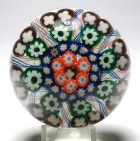 |
| 4963 | Rare Vasart / Lassman Checquer Pattern
Millefiori Paperweight Handle Bottle Opener. circa
1950s-1960s. This bottle opener has a rare checquer pattern
on the millefiori handle. It is possibly unique. The
firm of Lassman & Co. designed and produced this bottle opener
opener and a variety of other useful objects during the 1950s and
1960s. The attractive millefiori paperweight handle was made
by the Ysart family of Scotland under the Vasart label. The
handle has a checquer design with nine millefiori canes arranged
in a square surrounded by a latticinio square made up of four
short twist canes. There is a millefiori cane in the each
corner of the latticinio. The design is set on an amber
colored opaque ground. The chrome plated opener was made by
Lassman and the assembly was also done by them. The maker of this item was Lassman & Co. located in the Kilburn area of North London. Samuel Lassman purchased the paperweight handles from George Dunlop's Pirelli Glass in London. Pirelli obtained them from Vasart. Pirelli also took some assembled inventory back from Lassman and sold the barware items under the Pirelli label. Pirelli also included the line in their 1959 catalog. For more information, see my web page on Lassman & Co. or the article by Angela Bowey and Allan Port “Pirelli, Vasart and the Ysart Family” in the Paperweight Collectors Association Inc. Annual Bulletin 2015. A complete set of similar objects can be found at this link. The birth of Scottish paperweight making is credited to the glass making family of Salvador Ysart, who moved to Crieff, Scotland in 1922. They worked first at John Moncrieff Ltd and made the earliest Scottish paperweights during that period. In 1946 Salvadore and his sons Augustine and Vincent founded Ysart Brothers Glass and produced glass wares under the Vasart label. Salvador Ysart died in 1955 The company name was later changed to Vasart Glass. Stuart Drysdale was hired manage the business side of the enterprise in 1960. The company evolved into a new company Strathearn owned by Teachers Whiskey. In 1967 Drysdale was sent a magazine article on antique paperweights (Woman's Day, July 1965). The inspired him to try to produce weights comparable to the French antiques. With this goal in mind, he and several of the glass workers left Strathearn to found Perthshire in 1968. Size: 1 1/2" diameter. With the opener
hardware, it is 3 15/16" long. For extra pictures, click on the picture at the right and the following links: Large picture of the bottle openerNew Price $125 (was $245) postage paid in the US. Click on the picture to see a larger image. |
Click
on the picture to see a larger image |
| 6045 | John Deacons Magnum Garlanded
Pansy Paperweight with Clichy Style Millefiori Rose
Canes. circa 2020. This paperweight
features a delightful five petal red and orange pansy and bud with
dark green sepals, stem, and leaves surrounded by an alternating
garland of thirteen yellow and white Clichy style roses and
thirteen dark blue twist segments. The leaves and sepals
have aventurine added giving them a glittery appearance. The
pansy consists of two large deep red petals above over three
orange and black lower petals. Each lower petal has a pink tip
with three dark black lines radiating from center to the
tip. The design is set on a translucent dark purple
ground. The flower is two dimensional and lies even with the
ground. It is signed on the base with a "JD" signature cane
and also has a "HANDMADE IN SCOTLAND by John Deacons" paper
label. A creative composition with an unusual choice of
colors. This is one of the paperweights John Deacons
features on his website. Note: This was a challenging paperweight to photograph with its dark colors and high dome. The birth of Scottish paperweight making is credited to the glass making family of Salvador Ysart, who moved to Crieff, Scotland in 1922. They worked first at John Moncrieff Ltd and made the earliest Scottish paperweights during that period. In 1946 Salvadore and his sons Augustine and Vincent founded Ysart Brothers Glass and produced glass wares under the Vasart label. Salvador Ysart died in 1955 The company name was later changed to Vasart Glass. Strathearn Glass was formed in a reorganization of Vasart glass in 1963. John Deacons learned his craft at
Strathearn Glass in Crieff, Scotland in 1967. When Perthshire
was formed in 1968, he left Strathearn to move to Perthshire
and worked there for 10 years before leaving in 1978 to start
his own glass studio. He has produced paperweights and other
glass objects under a variety of labels, including J Glass,
St. Kilda, and now under his own name. Some of the lines were
produced simultaneously. J Glass was produced from 1978
to 1983. The St. Kilda line was produced from 1978 or
1979 through 1987. You can read about John Deacons in
the book by Hall - Scottish Paperweights. Today
John works at his own studio with his son Craig. Very large size: Just over 3 3/16" diameter by 2
7/16" high. The bottom is ground concave. For extra pictures, click on the picture at the right and the following links: Large picture$275 postage paid in the US. Click on the picture to see a larger image. |
Click
on the picture to see a larger image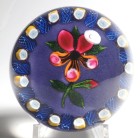 |
| 2020 |
Vasart / Lassman Millefiori Paperweight
Handle Bottle Opener with Original Box. circa
1950s-1960s. The firm of Lassman & Co. designed and
produced this bottle opener and a variety of other useful
objects during the 1950s and 1960s. The attractive
millefiori paperweight handle was made by the Ysart family of
Scotland under the Vasart label. The handle has a
concentric design on a rust colored ground that matches the
setup and canes of other Vasart paperweights. The chrome
plated opener was made by Lassman and the assembly was also done
by them. This item comes with its original box and
celluloid cover. The box is fabric lined (the original
advertisements said "silk lined") with elastics to hold
the bottle opener in place. A rare find for collectors of
barware and Scottish paperweights. The maker of this item was Lassman & Co. located in the Kilburn area of North London. Samuel Lassman purchased the paperweight handles from George Dunlop's Pirelli Glass in London. Pirelli obtained them from Vasart. Pirelli also took some assembled inventory back from Lassman and sold the barware items under the Pirelli label. Pirelli also included the line in their 1959 catalog. For more information, see my web page on Lassman & Co. or the article by Angela Bowey and Allan Port “Pirelli, Vasart and the Ysart Family” in the Paperweight Collectors Association Annual Bulletin 2015. A complete set of similar objects can be found at this link. The birth of Scottish paperweight making is credited to the glass making family of Salvador Ysart, who moved to Crieff, Scotland in 1922. They worked first at John Moncrieff Ltd and made the earliest Scottish paperweights during that period. In 1946 Salvadore and his sons Augustine and Vincent founded Ysart Brothers Glass and produced glass wares under the Vasart label. Salvador Ysart died in 1955 The company name was later changed to Vasart Glass. Stuart Drysdale was hired manage the business side of the enterprise in 1960. The company evolved into a new company Strathearn owned by Teachers Whiskey. In 1967 Drysdale was sent a magazine article on antique paperweights (Woman's Day, July 1965). The inspired him to try to produce weights comparable to the French antiques. With this goal in mind, he and several of the glass workers left Strathearn to found Perthshire in 1968. Size: Just over 1 1/2" diameter by just under 3
3/4" long. The box is just under 3" long by 2 11/16" wide
by 2 9/16" high. For extra pictures, click on the picture at the right and the following links: Large picture of the bottle opener$195 postage paid in the US. Click on the picture to see a larger image. |
Click on the picture to see a larger
image  |
| 2793 | Medium Colorful Strathearn Paneled
Millefiori Paperweight. circa 1963-1968. This
very attractive paperweight consists of a paneled millefiori
pattern with eight sections of 1+2+2 millefiori patterns each
separated by a white latticinio twist cane. There is a
central ring of six millefiori canes and then a center millefiori
cane. The canes are early Scottish millefiori canes on an
opaque blue ground. This is a very nice
example. A great addition to any collection of
Scottish paperweights.
The birth of Scottish paperweight making is credited to the glass making family of Salvador Ysart, who moved to Crieff, Scotland in 1922. They worked first at John Moncrieff Ltd and made the earliest Scottish paperweights during that period. In 1946 Salvadore and his sons Augustine and Vincent founded Ysart Brothers Glass and produced glass wares under the Vasart label. Salvador Ysart died in 1955 The company name was later changed to Vasart Glass. Strathearn Glass was formed in a reorganization of Vasart glass in 1963. The new company was owned by Teachers Whiskey. Medium Size: 2 9/16” diameter by 1 7/8”
high. Bottom is fire polished. For extra pictures, click on the picture at the right and the following links: Large picture$95 postage paid in the US. Click on the picture to see a larger image. |
Click
on the picture to see a larger image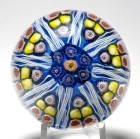 |
| 6256 | Magnum Caithness 1974 Colin Terris Peter
Holmes Fulmar Seabirds Limited Edition Paperweight.
dated 1974. This Caithness paperweight depicts two Fulmar
seabirds flying over a green and blue ocean. The birds are
engraved and/or sand blasted on the surface of the
paperweight. It was designed by Colin Terris and made by
Peter Holmes as part of the Sea Birds series. It comes with
its original (marked up) certificate noting that it was issued in
a limited edition of 500 paperweights of which this is number
321. It is engraved on the base "No. 321/500 Caithness
Scotland 1974". Something different from the early Caithness
years. Note: Although it is unusual for Caithness, the name FULMAR is not engraved on the base. The certificate and the picture in the catalog confirm the name of the paperweight. The FULMAR design is listed and designated CT-26 on page 9 of the Charlton Standard Catalog of Caithness Paperweights. It was designed in 1973 by Colin Terris and made by Peter Holmes. It was issued in a limited edition of 500 paperweights which was fully subscribed. Production continued into 1974 when this paperweight was made. Caithness Glass was founded by Robin Sinclair in Wick in north eastern Scotland in 1961. The factory did not start making paperweights until 1962 when Paul Ysart joined Caithness. Colin Terris joined Caithness in 1968 and started the modern line of paperweights in 1969. A second factory was opened in Oban in 1969 and the Perth factory opened in 1979. In 1980, Caithness purchased the Whitefriars name and designs. More recently Caithness recently went through a number of changes of ownership. After going into receivership in 2004, it was purchased by Edinburgh Crystal, but went into receivership again in 2006. Finally, it was bought out of receivership by Dartington Crystal. The factories in Wick, Oban and Perth all closed and were replaced by a smaller operation and visitors' center in Crieff. Caithness is still operating in Crieff and making paperweights today (in 2022). Very large size: Just over 3 1/4" diameter by 2
1/16" high. The base is polished flat. For extra pictures, click on the picture at the right and the following links: Large picture$85 postage paid in the US. Click on the picture to see a larger image. |
Click
on the picture to see a larger image |
| 6422 | Strathearn Large Closepack Millefiori
Paperweight. circa 1963-1968. Strathearn
paperweight with a close packed design of millefiori over an
opaque black ground. This classic design offers a variety of
early Strathearn or late Vasart canes. A well packed design
with no tipped canes. A fun paperweight which will be a
great addition to any collection of Scottish paperweights.
The birth of Scottish paperweight making is credited to the glass making family of Salvador Ysart, who moved to Crieff, Scotland in 1922. They worked first at John Moncrieff Ltd and made the earliest Scottish paperweights during that period. In 1946 Salvadore and his sons Augustine and Vincent founded Ysart Brothers Glass and produced glass wares under the Vasart label. Salvador Ysart died in 1955 The company name was later changed to Vasart Glass. Strathearn Glass was formed in a reorganization of Vasart glass in 1963. The new company was owned by Teachers Whiskey. The company is no longer in existence. Large size: 2 5/8” diameter by just over 2”
high. The base is fire polished. For extra pictures, click on the picture at the right and the following links: Large picture$125 postage paid in the US. Click on the picture to see a larger image. |
Click
on the picture to see a larger image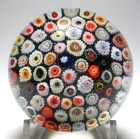 |
| 5290 | Large Colorful Strathearn Paneled
Millefiori Paperweight. circa 1963-1968. This
very attractive paperweight consists of a paneled millefiori
pattern with nine panels of 1 (yellow) + 2 (pink) millefiori canes
each separated by a white latticinio twist cane. There is a
central ring of eight dark red millefiori canes and then a
center pink and white millefiori cane. The canes are early
Scottish millefiori canes on an transparent green ground.
This is a great addition to any collection of Scottish
paperweights. Great color. The birth of Scottish paperweight making is credited to the glass making family of Salvador Ysart, who moved to Crieff, Scotland in 1922. They worked first at John Moncrieff Ltd and made the earliest Scottish paperweights during that period. In 1946 Salvadore and his sons Augustine and Vincent founded Ysart Brothers Glass and produced glass wares under the Vasart label. Salvador Ysart died in 1955 The company name was later changed to Vasart Glass. Strathearn Glass was formed in a reorganization of Vasart glass in 1963. The new company was owned by Teachers Whiskey. The company is no longer in existence. Large size: Just over 3” diameter by 2 1/8”
high. The base is fire polished with a remnant of the
pontil mark. For extra pictures, click on the picture at the right and the following links: Large picture$110 postage paid in the US. Click on the picture to see a larger image. |
Click on the picture
to see a larger image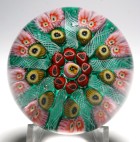 |
| 4680 | Large Early Selkirk Peter Holmes 1979
Aquarius Limited Edition Footed Paperweight. dated
1979. In my mind, this paperweight has an abstract
representation of the expression "the dawning of the age of
Aquarius" from the 1967 musical Hair, which was released on film
in 1979. That's my interpretation, you can have your
own. I see a large silvery bubble charged with green energy
suspended above a green sea. There are undefined bodies
rising from the surface to join the sphere. The paperweight
is an early design from Peter Holmes created shortly after
founding Selkirk Glass. It is signed in script on the edge
of the base "SELKIRK GLASS SCOTLAND AQUARIUS 102/350 1979",
indicating it is number 102 in a limited edition of 350
paperweights. It also has an early Peter Holmes "PH"
signature cane. Pedestal or footed paperweights like this
from Selkirk are rare, with only a few designs made in this
form. A imaginative paperweight in excellent condition. Selkirk Glass founded in 1977 by Peter Holmes and Ron Hutchinson. Peter apprenticed under Paul Ysart at Caithness from 1963 and continued at Caithness until 1977. Ron Hutchinson was also at Caithness. Selkirk produced a wide range of paperweight styles including abstract, lampwork and millefiori paperweights. The company was located in Selkirk, Scotland in the Borders Region. At some point they were purchased by Edinburgh Crystal and remained in operation until 2006. . Peter Holmes started his glass working career at Caithness Glass (Scotland) in 1963 as an apprentice to Paul Ysart. He continued at Caithness until 1977, when he and Ron Hutchinson left Caithness to start Selkirk Glass. Peter left Selkirk in 2002 to start Scottish Borders Art Glass with his son, Andrew, at Galalaw, Hawick. Large Size: 3" diameter by 2 7/8" high. There is
a footed base, which is 2 3/8" diameter. The bottom of the
foot is ground flat. For extra pictures, click on the picture at the right and the following links: Large pictureSOLD. Click on the picture to see a larger image. |
Click on the picture
to see a larger image 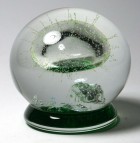 |
| Perthshire Paperweights. Please click on this link. | ||
| Peter McDougall Paperweights. Please click on this link. | ||
|
|
Caithness Helen MacDonald Red
Carnation Style One Paperweight. issued
1999. This beautiful paperweight features a crimp red
carnation set on a rich cobalt blue ground. There is a
contrasting field of controlled bubbles located top right.
It is finished with a small polished flat base and a large angled
facet. The carnation is set at an angle matching the
facet. This design was created by Helen MacDonald and issued
in 1999. The paperweight is engraved on the edge of the base
"Red Carnation Caithness Scotland" with a registration number
"Y17099". Please see note below about a scratched area on
the backside. A beautiful design. The RED CARNATION Style One design is listed on page 256 of the Charlton Standard Catalog of Caithness Paperweights. It was designed by Helen MacDonald and released in an unlimited edition in 1999. The original issue price in the US was $82.50 and the Charlton Catalog lists the 2004 current value as $500. Note about condition: This paperweight has an area on the backside near the base with many small scratches or abrasions (see picture). The area looks like a dirt smudge and I had to look with magnification to realize that this is damage. In spite of this, the paperweight displays beautifully. Offered for a bargain price. Caithness Glass was founded by Robin Sinclair in Wick in north eastern Scotland in 1961. The factory did not start making paperweights until 1962 when Paul Ysart joined Caithness. Colin Terris joined Caithness in 1968 and started the modern line of paperweights in 1969. A second factory was opened in Oban in 1969 and the Perth factory opened in 1979. In 1980, Caithness purchased the Whitefriars name and designs. More recently Caithness recently went through a number of changes of ownership. After going into receivership in 2004, it was purchased by Edinburgh Crystal, but went into receivership again in 2006. Finally, it was bought out of receivership by Dartington Crystal. The factories in Wick, Oban and Perth all closed and were replaced by a smaller operation and visitors' center in Crieff. Caithness is still operating in Crieff and making paperweights today (in 2022). Large size: 2 3/4" diameter by 2 11/16"
high. The small base is polished flat. It is faceted
with a large angled facet. For extra pictures, click on the picture at the right and the following links: Large picture$69 postage paid in the US. Click on the picture to see a larger image. |
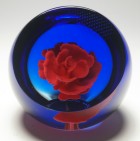 |
| 6042 | John Deacons Closepack
Paperweight with Clichy Style Roses on Lace. circa
2020. This paperweight features a colorful
closepacked assortment of Clichy style roses. The roses are
set on a white lace ground and are pulled down to the center of
the base. It is signed on the base with a "JD" signature
cane and also has a "HANDMADE IN SCOTLAND by John Deacons" paper
label. The birth of Scottish paperweight making is credited to the glass making family of Salvador Ysart, who moved to Crieff, Scotland in 1922. They worked first at John Moncrieff Ltd and made the earliest Scottish paperweights during that period. In 1946 Salvadore and his sons Augustine and Vincent founded Ysart Brothers Glass and produced glass wares under the Vasart label. Salvador Ysart died in 1955 The company name was later changed to Vasart Glass. Strathearn Glass was formed in a reorganization of Vasart glass in 1963. John Deacons learned his craft at
Strathearn Glass in Crieff, Scotland in 1967. When Perthshire
was formed in 1968, he left Strathearn to move to Perthshire
and worked there for 10 years before leaving in 1978 to start
his own glass studio. He has produced paperweights and other
glass objects under a variety of labels, including J Glass,
St. Kilda, and now under his own name. Some of the lines were
produced simultaneously. J Glass was produced from 1978
to 1983. The St. Kilda line was produced from 1978 or
1979 through 1987. You can read about John Deacons in
the book by Hall - Scottish Paperweights. Today
John works at his own studio with his son Craig. Large size: Just over 2 7/8" diameter by 2 1/8"
high. The base is ground concave. For extra pictures, click on the picture at the right and the following links: Large pictureSOLD. Click on the picture to see a larger image. |
Click on the picture
to see a larger image 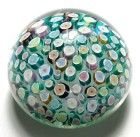 |
| 4062 | Large Caithness 1993 Margot Thomson Gold
Congratulations (Style Two) Abstract Paperweight.
issued in 1993. This abstract Caithness paperweight depicts
a woven gold "cap" with four descending tassels. There are
carefully placed bubbles at the corners of the cap and at the tip
of each tassel. All of this is surrounded by a mist of
transparent white glass. The paperweight is signed on
the base "Caithness CONGRATULATIONS Scotland" along with a
registration number "T89628". Designed by Margot
Thomson.
This design is listed and designated CT-985 on page 147 of the Charlton Standard Catalog of Caithness Paperweights. It was designed in 1993 by Margot Thomson as part of the Weight - Spherical series. The paperweight is recorded as coming in three colors (Gold, Ruby, and Silver). Caithness Glass was founded by Robin Sinclair in Wick in north eastern Scotland in 1961. The factory did not start making paperweights until 1962 when Paul Ysart joined Caithness. Colin Terris joined Caithness in 1968 and started the modern line of paperweights in 1969. A second factory was opened in Oban in 1969 and the Perth factory opened in 1979. In 1980, Caithness purchased the Whitefriars name and designs. More recently Caithness recently went through a number of changes of ownership. After going into receivership in 2004, it was purchased by Edinburgh Crystal, but went into receivership again in 2006. Finally, it was bought out of receivership by Dartington Crystal. The factories in Wick, Oban and Perth all closed and were replaced by a smaller operation and visitors' center in Crieff. Caithness is still operating in Crieff and making paperweights today (in 2022). Large size: 3 1/8" diameter by just under 2 7/8"
high. The base is polished flat. For extra pictures, click on the picture at the right and the following links: Large pictureSOLD. Click on the picture to see a larger image. |
Click
on the picture to see a larger image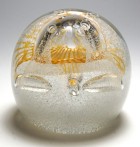 |
| 5027 | Faceted Harlequin Type
Paperweight with Five Icepick Bubbles - Possibly Unknown
European or Scottish. circa 1950 -1980.
Most likely made at an unknown European factory although
there is a slight possibility that it was made by a member of the
Ysart family. This paperweight has a large central bubble
and four side bubbles pushed down to a multi-colored frit
ground. It is similar to the Harlequin paperweights shown in
Colin Mahoney's book on Paul Ysart paperweights, but it not good
enough to be called a Paul Ysart Harlequin weight. There is
a tight ring of twelve thumbprint facets around the side near the
base. The glass has a lot of small bubbles. An
interesting study paperweight. Note: My first inclination was to call this Bohemian or unknown European, but I could not find any close matches in the literature. Similarly, it shares some characteristics with the harlequin paperweights shown in Colin Mahoney's book Masterpieces: The Paperweights of Paul Ysart, but is not a good match there either. The birth of Scottish paperweight making is credited to the glass making family of Salvador Ysart, who moved to Crieff, Scotland from Spain in 1922. They worked first at John Moncrieff Ltd and made the earliest Scottish paperweights during that period. Paul Ysart (1904-1991), originally Pablo Moreno Isart, was apprenticed to his father as a glass worker at Moncrieff in 1922. He worked on the production of Monart Art Glass. Paperweights were primarily an after hours activity. Paul made his first paperweight in the early 1930s. Production was interrupted by World War II and the Monart line was not restarted until 1946. In 1946 Salvadore and his sons Augustine and Vincent left Moncrieff and founded Ysart Brothers Glass. They produced glass wares under the Vasart label. Salvador Ysart died in 1955. Paul stayed at Moncrieff from until 1962, when he joined Caithness as a Training Officer. While at Caithness, he trained Peter Holmes, Colin Terris, and William Manson, among others. After he retired from Caithness in 1972, he continued to make paperweights initially under the Harland label and then the Highland Paperweights label until 1979. You can read more about Paul Ysart in the book by Colin Mahoney Masterpieces: The Paperweights of Paul Ysart. Large Size: 2 15/16" at the widest by 2 9/16"
high. The bottom is ground slightly concave. There
are twelve flat side facets For extra pictures, click on the picture at the right and the following links: Large picture of the paperweightSOLD. Click on the picture to see a larger image. |
Click
on the picture to see a larger image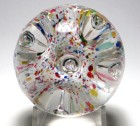 |
| 4344 | William Manson Phoenix Limited Edition
FP4 Pink Flower and Millefiori Garland Paperweight. dated
2003. This paperweight features a large pink flower
with a yellow millefiori center and leaves and stems surrounded by
a garland of identical millefiori canes. The design is set
on an almost opaque turquoise ground. This paperweight was
issued in a limited edition of 50 paperweights of which this is
number 30. It is signed and numbered "PHOENIX 2003 30/50" on
the base and also has a Phoenix "PP" signature cane near the
stem. Perfect condition with its original certificate and
slightly damaged Phoenix box. A great addition to any
collection of Scottish paperweights. Phoenix Paperweights was a small company started by William Manson Sr. to engage three workers from Perthshire after Perthshire closed in January 2002. They only lasted a year and issued paperweights in 2002 and 2003 before closing in August 2003. Phoenix operated in the Manson works in Perth, Scotland. The glass workers were William Manson Sr., David McNichol (paperweight maker), Duncan Smith (lampworking), and Gordon Taylor (glass cutter). Some of the lampwork was also done by Rosette Fleming. The 2003 Phoenix catalog lists William Manson Paperweights as the distributor. Large size: Just over 2 3/4" diameter by 1 7/8" high.
The base is ground concave. For extra pictures, click on the picture at the right and the following links: Large pictureSOLD. Click on the picture to see a larger image. |
Click
on the picture to see a larger image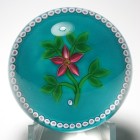 |
| 5651 | Magnum Selkirk
1986 Limited Edition Pink Crimp Rose Paperweight with
Certificate. dated 1986. This is a
delicate Selkirk pink crimp rose with twelve variegated
petals arranged in an unusual 2+2+2+2+2+2 crimp pattern. The
design is set on a clear ground. It is number 125 out of a
limited edition of 250 paperweights. It is signed in script
on the base "SELKIRK GLASS SCOTLAND 125/250 1986" and has its
original Selkirk silver foil label. It comes with its
original certificate. A flashy paperweight with great color
and execution. Crimp roses represent the ultimate challenge for paperweight makers. Selkirk Glass founded in 1977 by
Peter Holmes and Ron Hutchinson. Peter apprenticed under
Paul Ysart at Caithness from 1963 and continued at Caithness
until 1977. Ron Hutchinson, a graduate of Edinburgh
University, was also at Caithness. Selkirk produced a
wide range of paperweight styles including abstract, lampwork,
and millefiori paperweights. The company was located in
Selkirk, Scotland in the Borders Region. At some point
they were purchased by Edinburgh Crystal and remained in
operation until 2006. Large size: Just over 3 1/8" diameter by just
over 2 3/4" high. The base is ground concave. For extra pictures, click on the picture at the right and the following links: Large pictureSOLD. Click on the picture to see a larger image. |
Click
on the picture to see a larger image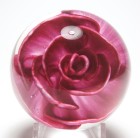 |
| 5652 | Magnum Selkirk 1990 Winter Breeze
Abstract Paperweight with Certificate. dated
1990. This abstract paperweights represents a winter breeze
churning up waves and swirling spray on a body of water. The
design is set on a blue and white ground with lots of controlled
bubbles and a pink center. It is signed in script on the
base "SELKIRK GLASS SCOTLAND WINTER BREEZE 1990" and has its
original Selkirk silver foil label. It comes with its
original certificate stating the design is by William
Lowery. A flashy paperweight with great color and execution. Selkirk Glass founded in 1977 by
Peter Holmes and Ron Hutchinson. Peter apprenticed under
Paul Ysart at Caithness from 1963 and continued at Caithness
until 1977. Ron Hutchinson, a graduate of Edinburgh
University, was also at Caithness. Selkirk produced a
wide range of paperweight styles including abstract, lampwork,
and millefiori paperweights. The company was located in
Selkirk, Scotland in the Borders Region. At some point
they were purchased by Edinburgh Crystal and remained in
operation until 2006. Very large size: 3 3/8" diameter by 3"
high. The base is ground concave. For extra pictures, click on the picture at the right and the following links: Large pictureSOLD. Click on the picture to see a larger image. |
Click
on the picture to see a larger image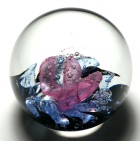 |
| 5894 | Large Faceted Strathearn Spaced
Millefiori on Lace Paperweight with Early Scottish Canes.
dated 1979. This fine Strathearn spaced millefiori on lace
paperweight features sixteen early Scottish millefiori canes that
were originally made in the Moncrieff (Monart) or Vasart
period. The paperweight was made by either David Moir or
Herbert Dreier and has a (distorted) Strathearn complex signature
cane "S 79" on the base. The paperweight is faceted with one
large top facet and five side facets. This would make a
fantastic addition addition to any collection of Scottish
paperweights. According to David Moir, the millefiori canes in this paperweight are old Monart type canes that were brought with by the Ysarts when they left Moncrieff. They were never used and kept out of the way until David Moir and Herbert Dreier were given permission to use them in 1979 by the management at Teachers Whiskey (who owned Strathearn). Some of the individual canes might be attributed to Salvadore during the early Vasart period rather than Monart. The birth of Scottish paperweight making
is credited to the glass making family of Salvador Ysart, who
moved to Crieff, Scotland in 1922. They worked first at
John Moncrieff Ltd and made the earliest Scottish paperweights
during that period. In 1946 Salvadore and his sons
Augustine and Vincent founded Ysart Brothers Glass and
produced glass wares under the Vasart label. Salvador
Ysart died in 1955 The company name was later changed to
Vasart Glass. Strathearn Glass was formed in a
reorganization of Vasart glass in 1963. The new company
was owned by Teachers Whiskey. The factory was taken
over by Stuart Glass in 1980 and renamed Stuart Strathearn
Ltd. After 1980, this factory ceased production of
paperweights and stopped all production in 1992. Stuart
Crystal ceased all operations in 2001. David Quintin Moir (born 1939) started as an apprentice at Vasart (Ysart Brothers Shore Road works) in 1954. He stayed when the name was changed to Strathearn and left in 1980. He often contributes to discussions of Scottish glass on Facebook. Herbert Dreier (born 1942 to an
Austrian coal-mining family) was originally destined to work
in the mines, but he left to join a glass factory in Bärnbach,
Austria where served a three year apprenticeship. In
1960, he moved to Germany where he worked for Peill Butzler,
Dren, Germany as a glass blower. He and a friend
responded to an advertisement for Caithness Glass and moved to
Wick, Scotland, where he worked as a glass blower under Paul
Ysart from 1963-65, later moving to Strathearn Glass as Master
Craftsman. He remained with Strathearn through the
takeover by Stuart Crystal and had a number of positions with
Stuart Crystal. When Stuart ceased operation in 2001, he
moved to Plowden & Thompson in Stourbridge as a Master
Craftsman. In a life-time devoted to the art of
glassblowing, Herbert Dreier’s repertoire encompassed
paperweights, lamp-bases, decorative bowls, vases and
three-dimensional decorative pieces. Size: 3” diameter by 2 3/16" high.
The base is polished flat. The paperweight is faceted with
one large top facet and five side facets. For extra pictures, click on the picture at the right and the following links: Large pictureSOLD. Click on the picture to see a larger image. |
Click
on the picture to see a larger image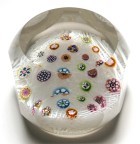 |
| 5648 | Magnum Selkirk 1988 Limited Edition
Abstract Calypso Paperweight with Certificate. dated
1988. This paperweight has a colorful abstract design
reminiscent of a twirling calypso dancer kicking up dust on the
ground. It is number 51 out of a limited edition of 500
paperweights. It is signed in script on the base "SELKIRK
GLASS SCOTLAND CALYPSO 51/500 1988" and comes with its original
certificate. A fantastic item from Selkirk Glass. Selkirk Glass founded in 1977 by
Peter Holmes and Ron Hutchinson. Peter apprenticed under
Paul Ysart at Caithness from 1963 and continued at Caithness
until 1977. Ron Hutchinson, a graduate of Edinburgh
University, was also at Caithness. Selkirk produced a
wide range of paperweight styles including abstract, lampwork
and millefiori paperweights. The company was located in
Selkirk, Scotland in the Borders Region. At some point
they were purchased by Edinburgh Crystal and remained in
operation until 2006. Very large size: 3 5/16" diameter by 2 3/16"
high. The bottom is ground concave. Magnum sized, it
weighs 28 ounces. For extra pictures, click on the picture at the right and the following links: Large pictureSOLD. Click on the picture to see a larger image. |
Click
on the picture to see a larger image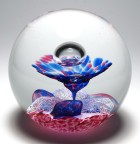 |
| 5428 | Rare 1974 Strathearn Faceted Upright Red
Flower Paperweight with Original Box. dated
1974. This is a rare Strathearn faceted five petal upright
red flower with three leaves and a stem. There is a
translucent red ground. It is designated PSF62 in the
catalog on Scotland's Glass and is part of the second series of
upright flower. It has a polished flat base. The
paperweight is faceted with a small top facet and eight side
facets (four large and four smaller below). There is a paper
label "STRATHEARN HAND MADE IN SCOTLAND" and Strathearn's "S 74"
signature cane on the base. It comes with its original satin
lined blue Strathearn Glass box. A great addition to any
collection of Scottish paperweights. The birth of Scottish paperweight making is credited to the glass making family of Salvador Ysart, who moved to Crieff, Scotland in 1922. They worked first at John Moncrieff Ltd and made the earliest Scottish paperweights during that period. In 1946 Salvadore and his sons Augustine and Vincent founded Ysart Brothers Glass and produced glass wares under the Vasart label. Salvador Ysart died in 1955 The company name was later changed to Vasart Glass. Strathearn Glass was formed in a reorganization of Vasart glass in 1963. The new company was owned by Teachers Whiskey. The company is no longer in existence. Large Size: 2 5/16” diameter by 3 1/2”
high. It has a polished flat base. The paperweight
is faceted with a small top facet and eight side facets (four
large and four smaller below). The box is 6 1/2" long by
4" wide by 3" high. For extra pictures, click on the picture at the right and the following links: Large pictureSOLD. Click on the picture to see a larger image. |
Click
on the picture to see a larger image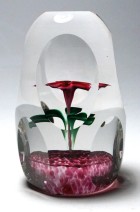 |
| 4285 | Magnum Caithness 1977 Colin
Terris Jubilee Moonflower Limited Edition Paperweight.
dated 1977. This paperweight is one of a group
of four Caithness paperweights created to celebrate the silver
jubilee of Queen Elizabeth II in 1977. The large spherical
Caithness paperweight features a celebratory fountain design with
four large bubbles and a center spray. There are nine
smaller bubbles at a lower level. The design is set over a
clear ground. This paperweight is engraved "EiiR 1952 -
1977" and the number 501. It is number 501 in a limited
edition of 3,000 paperweights. It also has a worn Caithness
label "CG HAND MADE IN SCOTLAND" with writing in blue ink on
it. A beautiful design. The JUBILEE MOONFLOWER design is listed and designated CT-70 on page 18 of the Charlton Standard Catalog of Caithness Paperweights. It was designed in 1977 by Colin Terris. It was released in a limited edition of 3,000 paperweights, all of which were made. This design was one of four paperweights in the HM Queen Elizabeth II Silver Jubilee Collection. Caithness Glass was founded by Robin Sinclair in Wick in north eastern Scotland in 1961. The factory did not start making paperweights until 1962 when Paul Ysart joined Caithness. Colin Terris joined Caithness in 1968 and started the modern line of paperweights in 1969. A second factory was opened in Oban in 1969 and the Perth factory opened in 1979. In 1980, Caithness purchased the Whitefriars name and designs. More recently Caithness recently went through a number of changes of ownership. After going into receivership in 2004, it was purchased by Edinburgh Crystal, but went into receivership again in 2006. Finally, it was bought out of receivership by Dartington Crystal. The factories in Wick, Oban and Perth all closed and were replaced by a smaller operation and visitors' center in Crieff. Very large size: Just under 3 3/16" diameter by 2
11/16" high. The base is polished flat. For extra pictures, click on the picture at the right and the following links: Large pictureSOLD. Click on the picture to see a larger image. |
Click
on the picture to see a larger image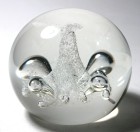 |
| 5621 | Miniature Strathearn Eight Pointed Star
Concentric Millefiori Paperweight with Opaque Turquoise Ground.
circa 1963-1968. This miniature paperweight features a three
ring concentric millefiori design and is finished as a eight
pointed star. The ground is an opaque turquoise. The
star points give the glass a glittery appearance. This
paperweight has a Strathearn paper label with a leaping salmon and
"STRATHEARN HAND MADE IN SCOTLAND" on the base. A great
addition to any collection of Scottish glass. This is called a pressed weight because a mold is used to form the shape. The top is flattened. The star points give the glass a real glittery appearance as you can see in the pictures. The birth of Scottish paperweight making is credited to the glass making family of Salvador Ysart, who moved to Crieff, Scotland in 1922. They worked first at John Moncrieff Ltd and made the earliest Scottish paperweights during that period. In 1946 Salvadore and his sons Augustine and Vincent founded Ysart Brothers Glass and produced glass wares under the Vasart label. Salvador Ysart died in 1955 The company name was later changed to Vasart Glass. Strathearn Glass was formed in a reorganization of Vasart glass in 1963. The new company was owned by Teachers Whiskey. Miniature size: 2” diameter by 1 3/16”
high. The base is fire polished. For extra pictures, click on the picture at the right and the following links: Large pictureSOLD. Click on the picture to see a larger image. |
Click
on the picture to see a larger image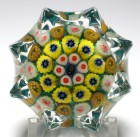 |
| 5567 | Caithness Colin Terris
Ballerina Limited Edition Flash Overlay Paperweight.
issued 1993. This stunningly beautiful
paperweight uses a pink swirl of lacy bubbles to depict a twirling
ballerina. The design is placed at the center of a
transparent cobalt blue flash overlay. This design was
created by Colin Terris in 1993 and issued in a very limited
edition of only 50 paperweights, of which this is number 42.
It is faceted with one large top facet and twelve smaller side
facets in two rows. The paperweight is engraved on the edge
of the base "Ballerina Caithness Scotland 42/50". It also
has Selman auction label. A beautiful design. The BALLERINA design is listed and designated CT-931 on page 140 of the Charlton Standard Catalog of Caithness Paperweights. It was designed in 1993 by Colin Terris and released in a limited edition of only 50 paperweights. The original issue price in the US was $595 and the Charlton Catalog lists the 2004 current value as $350. Note about provenance: The previous owner acquired this paperweight at the Selman Auction 44 (Fall 2009) Lot 298. The auction estimate was $180-$250. Caithness Glass was founded by Robin Sinclair in Wick in north eastern Scotland in 1961. The factory did not start making paperweights until 1962 when Paul Ysart joined Caithness. Colin Terris joined Caithness in 1968 and started the modern line of paperweights in 1969. A second factory was opened in Oban in 1969 and the Perth factory opened in 1979. In 1980, Caithness purchased the Whitefriars name and designs. More recently Caithness recently went through a number of changes of ownership. After going into receivership in 2004, it was purchased by Edinburgh Crystal, but went into receivership again in 2006. Finally, it was bought out of receivership by Dartington Crystal. The factories in Wick, Oban and Perth all closed and were replaced by a smaller operation and visitors' center in Crieff. Caithness is still operating in Crieff and making paperweights today (in 2022). Large size: Just under 3 1/8" diameter by just
under 2 7/16" high. The base is polished flat. It is
faceted with one large top facet and twelve smaller side facets
in two rows. For extra pictures, click on the picture at the right and the following links: Large pictureSOLD. Click on the picture to see a larger image. |
Click
on the picture to see a larger image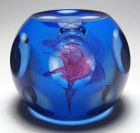 |
| 5363 | Large Strathearn Spaced Millefiori on
Lace Paperweight. 1963 - 1980. This Strathearn
spaced millefiori on lace paperweight features twelve colorful
millefiori canes in a randomly spaced pattern. The design is
placed on a white lace (or upset muslin) ground. This
paperweight has a Strathearn paper label with a leaping salmon and
"STRATHEARN HAND MADE IN SCOTLAND" on the base. A great
addition to any collection of Scottish glass.
The birth of Scottish paperweight making
is credited to the glass making family of Salvador Ysart, who
moved to Crieff, Scotland in 1922. They worked first at
John Moncrieff Ltd and made the earliest Scottish paperweights
during that period. In 1946 Salvadore and his sons
Augustine and Vincent founded Ysart Brothers Glass and
produced glass wares under the Vasart label. Salvador
Ysart died in 1955 The company name was later changed to
Vasart Glass. Strathearn Glass was formed in a
reorganization of Vasart glass in 1963. The new company
was owned by Teachers Whiskey. The factory was taken
over by Stuart Glass in 1980 and renamed Stuart Strathearn
Ltd. After 1980, this factory ceased production of
paperweights and stopped all production in 1992. Stuart
Crystal ceased all operations in 2001. Size: Just over 3” diameter by 2 1/8"
high. The base is polished flat. For extra pictures, click on the picture at the right and the following links: Large picture$175 postage paid in the US. Click on the picture to see a larger image. |
Click
on the picture to see a larger image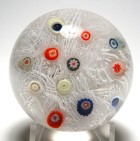 |
| 5566 | Large Colorful Strathearn Paneled
Millefiori Paperweight. circa 1963-1968. This
very attractive paperweight consists of a paneled millefiori
pattern with nine panels of 1 (blue) + 2 (red) + 2 (orange and
white) millefiori patterns each separated by a white latticinio
twist cane. There is a central ring of seven dark blue
millefiori canes and then a center orange and white millefiori
cane. The canes are early Scottish millefiori canes on an
opaque black ground. This paperweight has its original
Strathearn paper label "STRATHEARN HAND MADE IN SCOTLAND" on the
base. It also has a sticker from an early Selman
auction. This is a great addition to any collection of
Scottish paperweights. Great color. This paperweight has a sticker on the base from an early Selman Online Auction (Auction 7 Lot 68). This is online auction is different from the auctions that had print catalogs. The previous owner paid $200 for this paperweight. The birth of Scottish paperweight making is credited to the glass making family of Salvador Ysart, who moved to Crieff, Scotland in 1922. They worked first at John Moncrieff Ltd and made the earliest Scottish paperweights during that period. In 1946 Salvadore and his sons Augustine and Vincent founded Ysart Brothers Glass and produced glass wares under the Vasart label. Salvador Ysart died in 1955 The company name was later changed to Vasart Glass. Strathearn Glass was formed in a reorganization of Vasart glass in 1963. The new company was owned by Teachers Whiskey. The company is no longer in existence. Large size: Just under 3” diameter by 2
1/4” high. The base is fire polished. For extra pictures, click on the picture at the right and the following links: Large pictureSOLD. Click on the picture to see a larger image. |
Click on the picture to see a larger image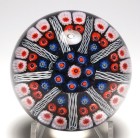 |
| 3437 | Large Colorful Strathearn Paneled
Millefiori Paperweight. circa 1963-1968. This
very attractive paperweight consists of a paneled millefiori
pattern with nine panels of 1 (white) + 2 (yellow) + 2 (pink)
millefiori patterns each separated by a white latticinio twist
cane. There is a central ring of seven dark green
millefiori canes and then a center orange millefiori cane.
The canes are early Scottish millefiori canes on a translucent
blue ground. This is a great addition to any collection of
Scottish paperweights. Great color. The birth of Scottish paperweight making is credited to the glass making family of Salvador Ysart, who moved to Crieff, Scotland in 1922. They worked first at John Moncrieff Ltd and made the earliest Scottish paperweights during that period. In 1946 Salvadore and his sons Augustine and Vincent founded Ysart Brothers Glass and produced glass wares under the Vasart label. Salvador Ysart died in 1955 The company name was later changed to Vasart Glass. Strathearn Glass was formed in a reorganization of Vasart glass in 1963. The new company was owned by Teachers Whiskey. The company is no longer in existence. Size: 3 1/16” diameter by 2 5/16”
high. The base is fire polished. For extra pictures, click on the picture at the right and the following links: Large picture$125 postage paid in the US. Click on the picture to see a larger image. |
Click
on the picture to see a larger image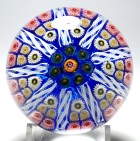 |
| 4034 | Medium Colorful Strathearn Close Packed
Millefiori Paperweight. circa 1963-1968. This is
a very attractive and colorful Strathearn close packed millefiori
paperweight. The design is placed over an opaque pink- beige
ground. A nice addition to any collection of Scottish
paperweights. The birth of Scottish paperweight making is credited to the glass making family of Salvador Ysart, who moved to Crieff, Scotland in 1922. They worked first at John Moncrieff Ltd and made the earliest Scottish paperweights during that period. In 1946 Salvadore and his sons Augustine and Vincent founded Ysart Brothers Glass and produced glass wares under the Vasart label. Salvador Ysart died in 1955 The company name was later changed to Vasart Glass. Strathearn Glass was formed in a reorganization of Vasart glass in 1963. The new company was owned by Teachers Whiskey. The company is no longer in existence. Medium size: Just over 2 3/8” diameter by 2
1/16” high. The base is fire polished and ground concave
in the center. For extra pictures, click on the picture at the right and the following links: Large pictureSOLD. Click on the picture to see a larger image. |
Click
on the picture to see a larger image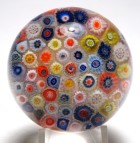 |
| 2836 | Selkirk 1996 Stylized Blue Flower
Paperweight. dated 1996. This paperweight has
an stylized or abstract blue floral design with five trumpet
shaped petals and a green center. Each of the trumpet shapes
has an elongated bubble in the center. The design is placed
over a translucent blue ground. It is signed in script on
the base "SELKIRK GLASS SCOTLAND 1996". It also has a worn
paper label "SELKIRK GLASS HANDMADE IN SCOTLAND". A
colorful example from Selkirk Glass. Selkirk Glass founded in 1977 by Peter Holmes and Ron Hutchinson. Peter apprenticed under Paul Ysart at Caithness from 1963 and continued at Caithness until 1977. Ron Hutchinson was also at Caithness. Selkirk produced a wide range of paperweight styles including abstract, lampwork and millefiori paperweights. The company was located in Selkirk, Scotland in the Borders Region. At some point they were purchased by Edinburgh Crystal and remained in operation until 2006. . Peter Holmes started his glass working career at Caithness Glass (Scotland) in 1963 as an apprentice to Paul Ysart. He continued at Caithness until 1977, when he and Ron Hutchinson left Caithness to start Selkirk Glass. Peter left Selkirk in 2002 to start Scottish Borders Art Glass with his son, Andrew, at Galalaw, Hawick. Large size: 2 13/16" diameter by 2 5/8" high. The
bottom is ground concave. For extra pictures, click on the picture at the right and the following links: Large picture$95 postage paid in the US. Click on the picture to see a larger image. |
Click
on the picture to see a larger image
|
Back to Allan's Paperweights (www.paperweights.com)
Revised 11/26/2025 EI9